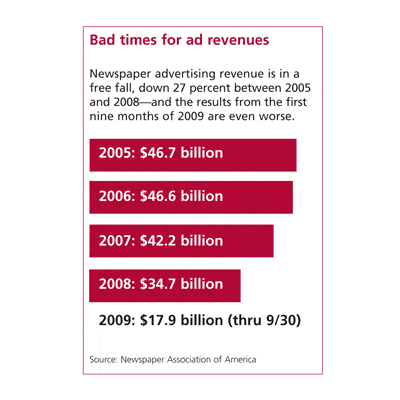Death of a Newspaperman
News media — including newspapers, news weeklies and TV news programs — was struggling long before the 2008 financial crisis and subsequent recession. In 2009 alone more than 100 newspapers shut down across the United States.
With 24-hour TV and web news cycles, physical newspaper distribution has become somewhat of an inconvenience. That combined with the mounting costs of printing and delivery, and the loss of classified ad revenue, news media is in the middle of a crisis.

Traditional Ad Spend is Down
Newspaper revenue fell 28% in the first three quarters of 2009, after declines of 17.7% in 2008 and 9.4% in 2007, and 15,000 employees were laid off in 2009 alone. Circulation has also declined to pre-World War II levels, which is shocking since the population of the U.S. at the time was half of what it is today.
With a decline in subscriptions came a decline in the value of print ads. Newsweek lost 25% and Time lost 18% of their subscribers, while U.S. News & World Report moved completely to the internet.
Now many news companies are trying to put a price tag on all their online material, which is hard for many to swallow considering the fact that it has been free to the public for so long.
These are just some of the many challenges that news media companies are facing. And while this story strikes many as devastating, others find it inspiring. Digital and virtual news media platforms are replacing older mediums of new reporting, showing that the world is becoming more and more dependent on internet-based media. With that in mind, everybody is going to have to make changes in their plans and make way for new technologies. If not, one might end up like the newspaper industry.

